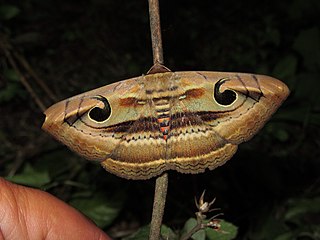
Erebus macrops is a species of moth of the family Erebidae first described by Carl Linnaeus in 1768. It is found in the subtropical regions of Africa and Asia. The wingspan is about 12 cm, making it exceptionally large for an Erebidae species. The larvae feed on Acacia and Entada species.

Hulodes caranea is a species of moth of the family Erebidae first described by Pieter Cramer in 1780. It is found from India, Sri Lanka, Myanmar, Java, Hong Kong to Queensland and New Guinea, it is also found on the Marianas and Carolines.

Speiredonia itynx is a species of moth of the family Erebidae first described by Johan Christian Fabricius in 1787. It is found in India, Sri Lanka, Vietnam, Java, Palawan, Sulawesi and the Moluccas.

Thyas coronata is a species of moth of the family Noctuidae first described by Johan Christian Fabricius in 1775. It is found from the Indo-Australian tropics of southern China, Taiwan, Japan, Nepal, India, Sri Lanka to Micronesia and the Society Islands.

Acronicta pruinosa is a moth of the family Noctuidae. It is found in Sri Lanka, the Himalaya, east to Japan and Taiwan south to Myanmar and Peninsular Malaysia, Borneo, Java and New Guinea.

Scopula divisaria is a moth of the family Geometridae. It is found from the Indian subregion, Sri Lanka to Taiwan and Sulawesi.

Chiasmia emersaria is a moth of the family Geometridae. The species was first described by Francis Walker in 1861. It is found in India, Nepal, northern Thailand, China, Sri Lanka, Japan and the Ryukyu Islands.

Eucyclodes gavissima, the Oriental orange banded green geometer moth, is a species of moth of the family Geometridae described by Francis Walker in 1861. It is found in the Indian subregion, Sri Lanka, Bhutan, western China, Taiwan, Sumatra and Borneo.

Calluga costalis is a moth of the family Geometridae. The species was first described by Frederic Moore in 1887. It is found in Sri Lanka, Taiwan, Borneo, Bali, Sulawesi, Seram, New Guinea and Queensland.

Spirama retorta, the Indian owlet-moth, is a moth of the family Erebidae. The species was first described by Carl Alexander Clerck in 1764. It is found in China, Korea, Japan (Honshu), India, Nepal, Bangladesh, Thailand, Cambodia, Myanmar, Vietnam, Taiwan, Sri Lanka, Malaysia, the Philippines (Luzon), Indonesia ,Japan.

Hyperythra lutea is a moth in the family Geometridae. The species was first described by Caspar Stoll in 1781. It is found in Indian subregion, Sri Lanka, South East Asia, Sundaland.
Scopula adeptaria is a moth of the family Geometridae. It was described by Francis Walker in 1861. It is found in Sri Lanka, India, Taiwan, Hainan, southern Myanmar, Peninsular Malaysia, Borneo, the Philippines, Sumba and northern Australia.
Amyna punctum is a moth of the family Noctuidae first described by Johan Christian Fabricius in 1794. This moth can be found throughout subtropical African countries such as South Africa, Madagascar and Australasian countries like India, Sri Lanka, the Philippines, Borneo and the Andaman Islands.
Axinoptera subcostalis is a moth in the family Geometridae. It was first described by George Hampson in 1893 and is found in Sri Lanka.
Eriopithex recensitaria is a moth in the family Geometridae first described by Francis Walker in 1862. It is found in Sri Lanka, Taiwan, on Borneo and in the Australian state of Queensland.
Gymnoscelis imparatalis, the flower-looper moth, is a moth in the family Geometridae. It is found from the Indo-Australian tropics of India, Sri Lanka, east to the Society Islands and the Marquesas Archipelago. The habitat consists of both lowland and montane ecosystems.

Hypomecis separata is a species of moth of the family Geometridae. It was first described by Francis Walker in 1863. It is found in Sri Lanka, India, Java and Borneo.

Erebus hieroglyphica is a moth of the family Erebidae. It is found from the Oriental tropical countries such as India, Pakistan, Sri Lanka, Bangladesh, Japan, China, Taiwan, Cambodia, Laos, Myanmar, Thailand, Vietnam, Indonesia, Philippines, Malaysia, Singapore, and Korea. The habitat consist of lowland forests.

Hypopyra vespertilio is a moth of the family Erebidae first described by Johan Christian Fabricius in 1787. It is found in China, Korea, Honshu in Japan, India, Sri Lanka, Nepal, Thailand, Myanmar, Cambodia, Vietnam, Taiwan, Malaysia, the Philippines, Java, Sumatra and Sulawesi.
Episparis liturata is a moth of the family Noctuidae first described by George Hampson in 1893. It is found in India, Sri Lanka, Java, Borneo, Myanmar, China and Thailand.













